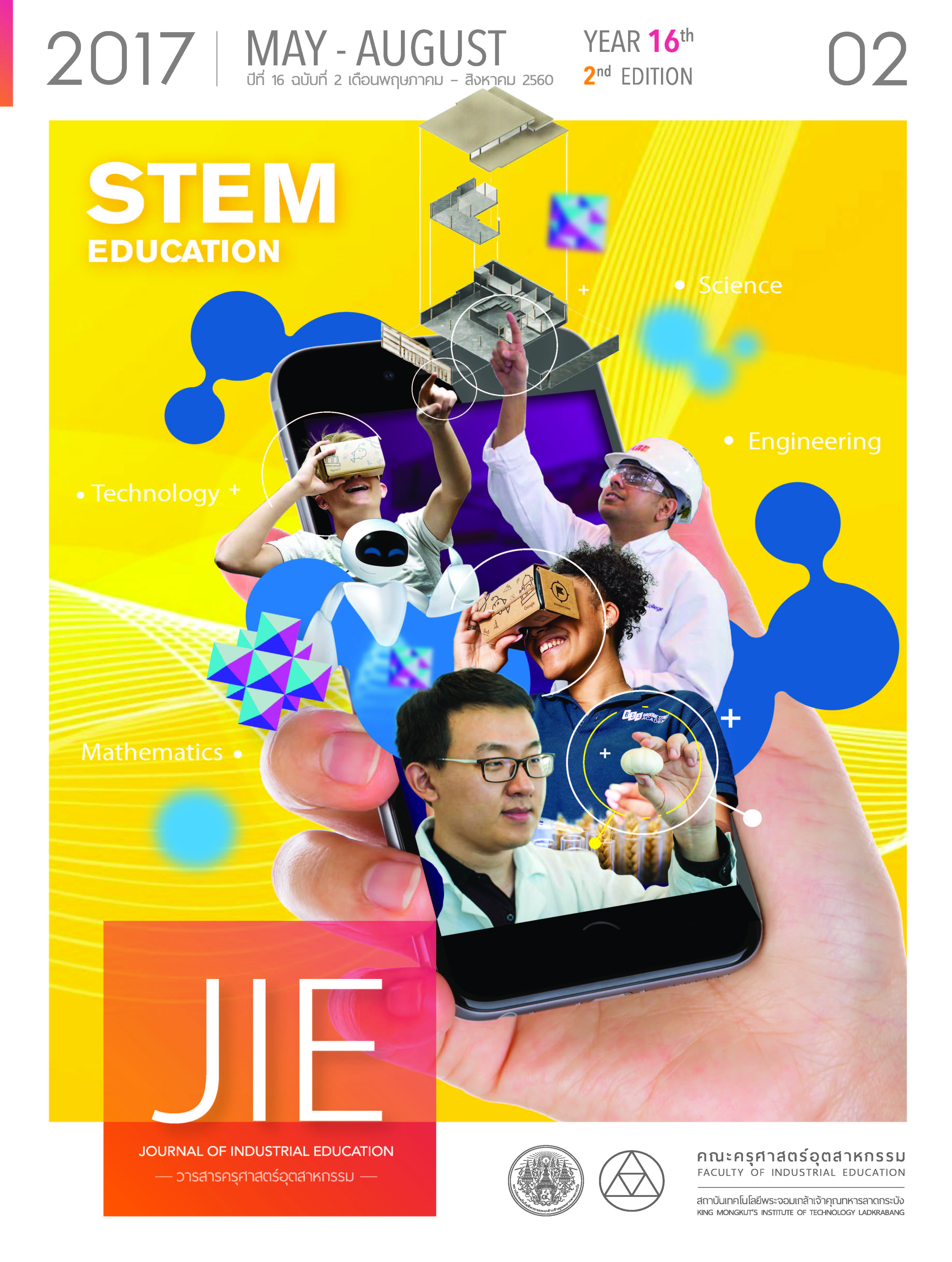การพัฒนาการเรียนรู้แบบผสมผสานผ่านบทเรียนบนเครือข่ายอินเทอร์เน็ต เรื่อง การทำงานแบบมีเงื่อนไขและวนซ้ำ ชั้นมัธยมศึกษาปีที่ 1
Main Article Content
บทคัดย่อ
การวิจัยครั้งนี้มีวัตถุประสงค์เพื่อพัฒนาการเรียนรู้แบบผสมผสานผ่านบทเรียนบนเครือข่ายอินเทอร์เน็ต เรื่อง การทำงาน
แบบมีเงื่อนไขและวนซ้ำ ให้มีคุณภาพและประสิทธิภาพ และเปรียบเทียบผลสัมฤทธิ์ทางการเรียนหลังเรียน เรื่อง การทำงาน
แบบมีเงื่อนไขและวนซ้ำ ชั้นมัธยมศึกษาปีที่ 1 ระหว่างกลุ่มที่เรียนด้วยการเรียนรู้แบบผสมผสานผ่านบทเรียนบนเครือข่ายอินเทอร์เน็ตกับกลุ่มที่เรียนด้วยการเรียนรู้แบบปกติ กลุ่มตัวอย่างที่ใช้ในการวิจัยคือ นักเรียนชั้นมัธยมศึกษาปีที่ 1 โรงเรียน
พนัสพิทยาคาร ภาคเรียนที่ 2 ปีการศึกษา 2559 ได้จากการสุ่มแบบแบ่งกลุ่ม จำนวน 120 คน โดยจำแนกเป็น 3 กลุ่ม ดังนี้
กลุ่มที่ 1 สำหรับหาประสิทธิภาพ จำนวน 40 คน กลุ่มที่ 2 เป็นกลุ่มทดลองสำหรับเปรียบเทียบผลสัมฤทธิ์ทางการเรียน จำนวน 40 คน และกลุ่มที่ 3 เป็นกลุ่มควบคุมสำหรับเปรียบเทียบผลสัมฤทธิ์ทางการเรียน จำนวน 40 คน เครื่องมือที่ใช้ในการวิจัยประกอบด้วย แบบประเมินคุณภาพบทเรียน และแบบทดสอบวัดผลสัมฤทธิ์ทางการเรียนที่มีค่าความยากง่ายตั้งแต่ 0.25-0.78 ค่าอำนาจจำแนก 0.30-0.65 และค่าความเชื่อถือได้เท่ากับ 0.70 สถิติที่ใช้ในการวิเคราะห์ข้อมูล ได้แก่ ค่าเฉลี่ย ส่วนเบี่ยงเบนมาตรฐาน และการทดสอบที (t-test) แบบ independent
ผลการวิจัยพบว่า
- การเรียนรู้แบบผสมผสานผ่านบทเรียนบนเครือข่ายอินเทอร์เน็ต เรื่อง การทำงานแบบมีเงื่อนไขและวนซ้ำ ชั้นมัธยมศึกษา
ปีที่ 1 มีคุณภาพด้านเนื้อหาอยู่ในระดับดีมาก (= 4.72 and S.D. = 0.46) คุณภาพด้านเทคนิคการผลิตสื่ออยู่ในระดับดีมาก (
= 4.55 and S.D. = 0.50) และคุณภาพโดยรวมอยู่ในระดับดีมาก (
= 4.58 and S.D. = 0.50)
- ประสิทธิภาพของบทเรียนบนเครือข่ายอินเทอร์เน็ต เรื่อง การทำงานแบบมีเงื่อนไขและวนซ้ำ ชั้นมัธยมศึกษาปีที่ 1 เท่ากับ 75.63/75.13
- นักเรียนชั้นมัธยมศึกษาปีที่ 1 ที่เรียนด้วยการเรียนรู้แบบผสมผสานผ่านบทเรียนบนเครือข่ายอินเทอร์เน็ต เรื่อง การทำงานแบบมีเงื่อนไขและวนซ้ำ มีผลสัมฤทธิ์ทางการเรียนสูงกว่านักเรียนที่เรียนด้วยการเรียนรู้แบบปกติอย่างมีนัยสำคัญที่ระดับ 0.01
Article Details
"ข้อคิดเห็น เนื้อหา รวมทั้งการใช้ภาษาในบทความถือเป็นความรับผิดชอบของผู้เขียน"
References
[2] Thanomporn Laohajaratsang. 2002. Designing e-Learning. Bangkok : Aroonkarnpim.
[3] Pratuang Wiboonsak. 2010. Blended learning and Mixed Method. Retrieved November 21,2016,fromhttps://www.sahavicha.com/name=blog&file=readblog&id=5720
[4] Seels B. and Glasgow Z. 1998. Making Instructional Design Decisions. 2nd ed. Upper Saddle River NJ : Merrill. p 7.
[5] Carman, J.M. 2005. Blended learning design: Five key ingredients. Retrieved November 21, 2016, from www.agilantlearning.com/pdf/Blended Learning Design.pdf
[6] Priroj Teeranatanakil, Paiboon Kiattikomol and Saksun Yampinij. 2003. Design and producing computer instruction package for e-Learning. Bangkok : Sun Sue Some Krungthep.
[7] Chaiyong Brahmawong. 2013. Developmental Testing of Media and Instructional. Silpakorn Educational Research Journal, 5(1), p. 7-19.
[8] Bloom, B.S. 1976. Human Characteristic and school Learning.New York : McGraw - Hill Book Company.
[9] Thanakorn Khanthakhet. 2015. The Development of a Blended Learning Model Emphasizingon Information and Communication Technology Literacy Characteristic. Doctor degree of Educational Technology Faculty of Education, Srinakharinwirot University.
[10] Sugree Rodpothong. 1998. Computer Assisted Instruction Design. Nonthaburi : Sukhothai Thammathirat Open University.
[11] Thanongsak Chaichuensaen. 2016. A Development of Blended Learning with the Integration of Web-based Instruction VIA Cloud Computing on Bench Work and the Electronic Circuits of Undergraduate Student. Master degree of Industrial Education. Faculty of Industrial Education In Branch Education Technology, King Mongkut’s Institute of Technology Ladkrabang.
[12] Sunrach Horสรรรัชต์ ห่อไพศาล. 2544. Innovation and Education Technology Application in the new Millennium : Web Based Instruction. SPU Research, 1(2) : 93-104.
[13] Kanjana Sitthiratanayuenyong. 2015. The Blended Learning Model to Develop the Achievement on Statement Loop Programming Subject of Upper Secondary Benchamaratrangsarit School Chachoengsao. Master degree of Science. Faculty of Industrial Education, King Mongkut’s Institute of Technology Ladkrabang.
[14] Ayala, J. (2009). Blended Learning As A New Approach To Social Work Education. Journal of Social Work Education Volume 45, Issue 2.
[15] Graham, C.R. 2013. Emerging practice and research in blended learning. Retrieved November 21, 2016, from www.academia.edu/2068375/
[16] Narumon Antarikanon. 2008. The Development of Online Lessons on Webpage Development with Dreamweaver for the Central Regional Institute for Non-formal Education and Informal Education Students. KKU Research Journal, 13(11) : 1298-1309.
[17] Abhichat Anukulwech. 2012. Blended learning. Retrieved November 21, 2016, from https://www.chon tech.ac.th/~abhichat/1/index.php? option=com_content&task=view&id=222
[18] Allan, B. 2004. Blended learning tool for teaching and training. UK: Facet Publishing.
[19] Soontaree Nilbuaklee. 2014. Effect of Blended Learning on Learning Achievement in Baking Cake for Sophomore Students of Bachalor Degree at Dusit Thani College. Master degree of Industrial Education. Faculty of Industrial Education, King Mongkut’s Institute of Technology Ladkrabang.

